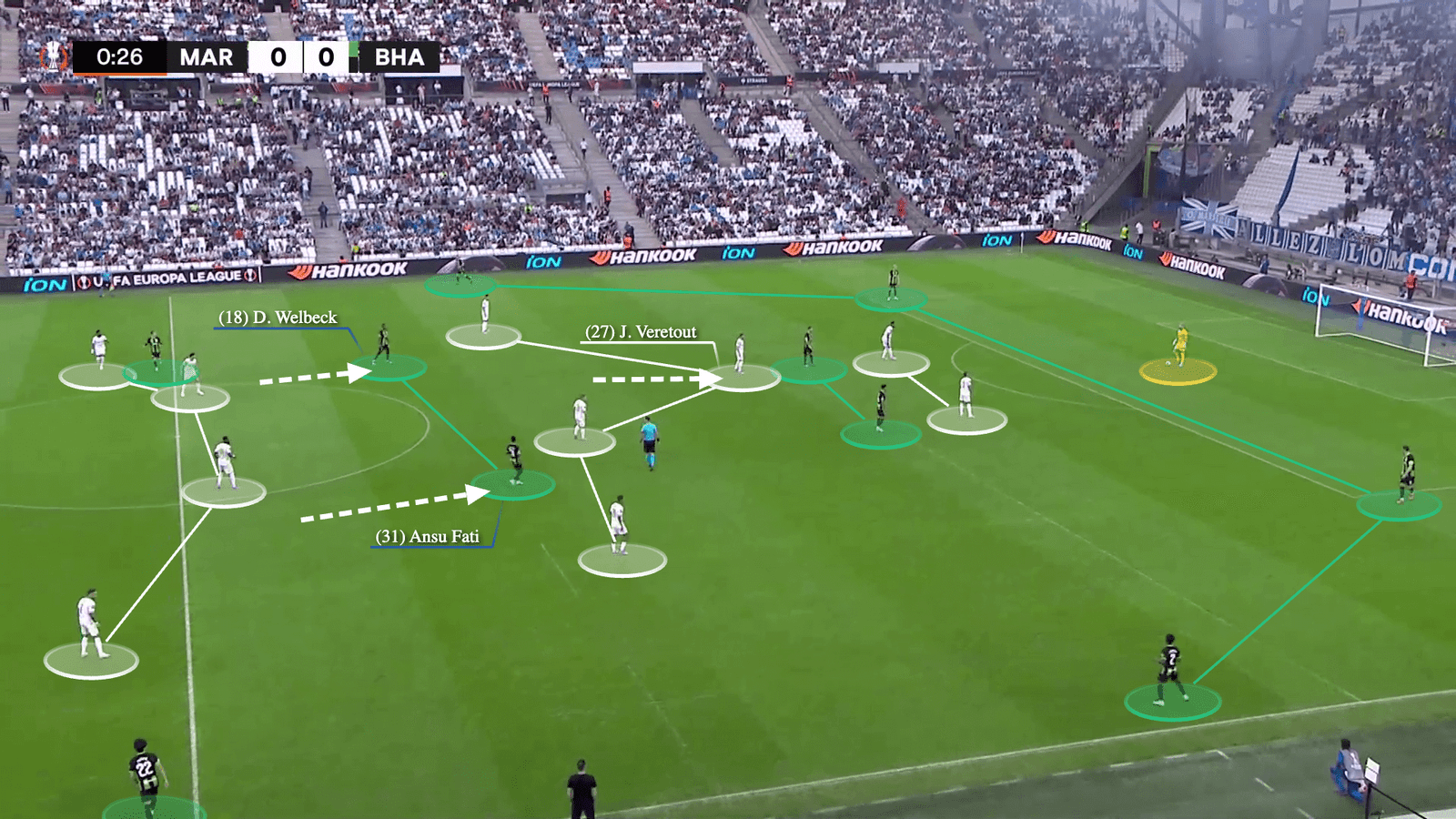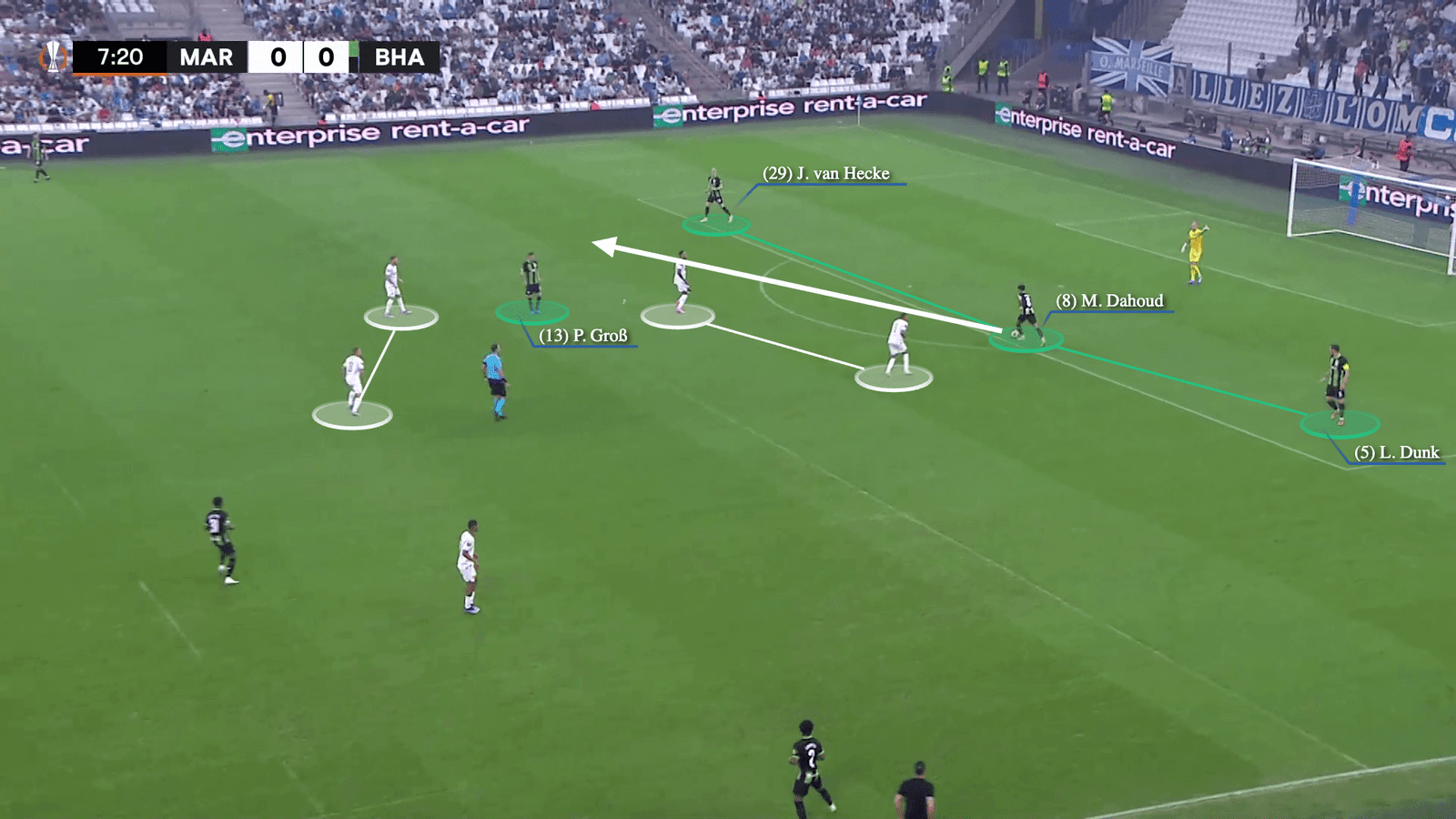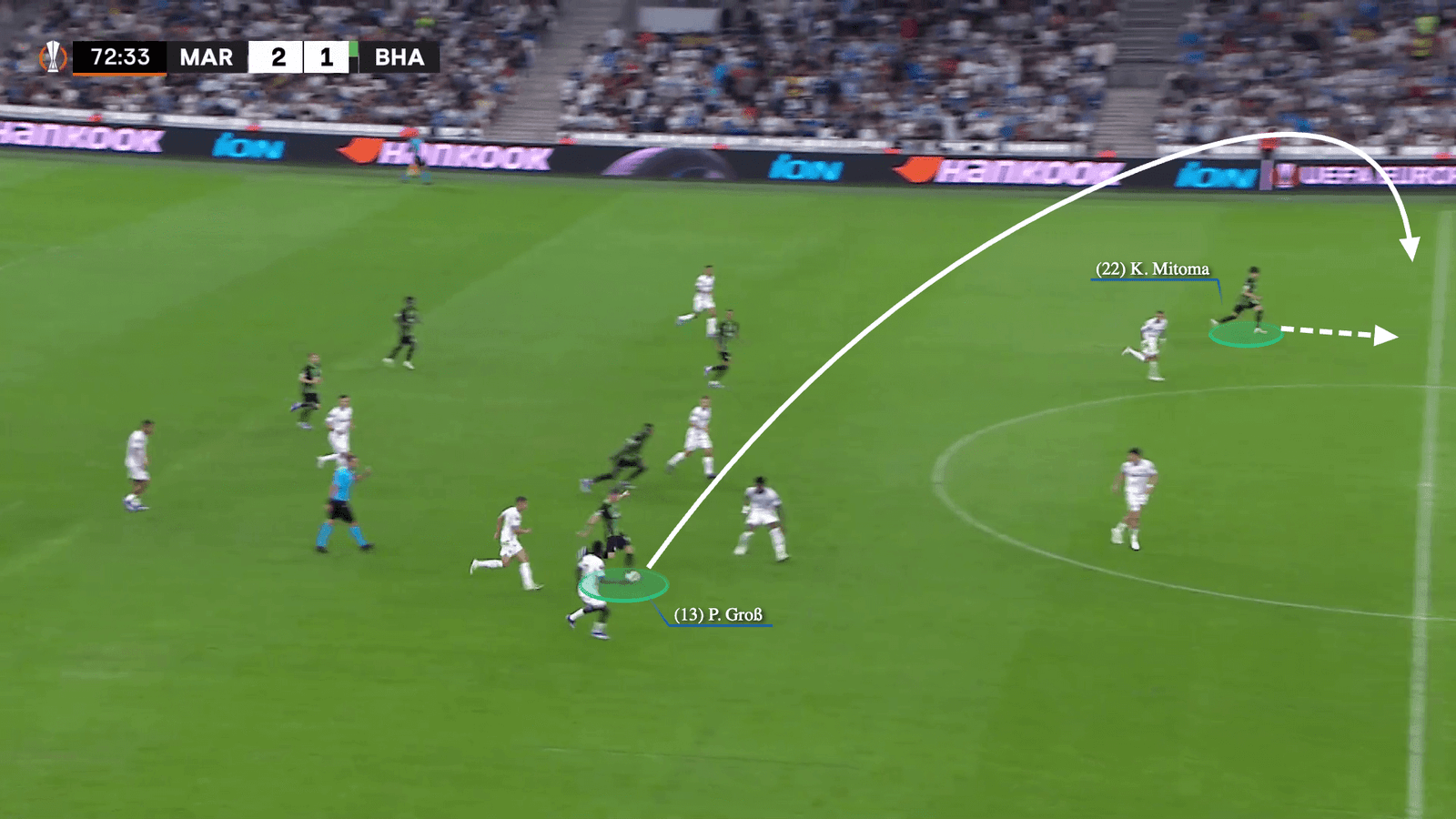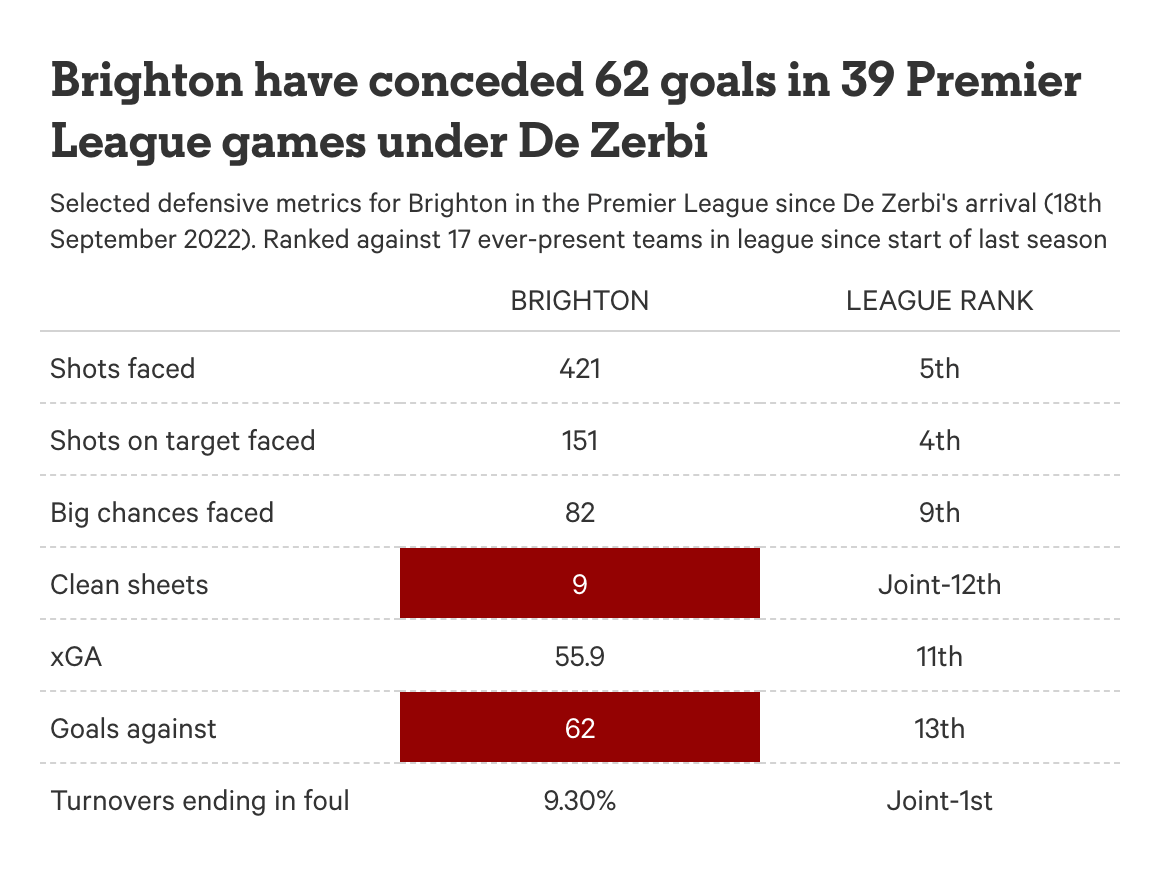Roberto De Zerbi was candid after Brighton & Hove Albion’s 2-2 draw in Marseille.
“I think we are not playing well, it is a very tough period for us. I’m not a big coach, I’m not used to playing this competition — we have to adapt.”
Brighton did adapt, but they did not start as the “different Brighton” that De Zerbi promised in response to last weekend’s 6-1 away defeat against Aston Villa. In Marseille, like at Villa Park, Brighton were 2-0 down inside 25 minutes after conceding almost identical cutback goals down their left side. Chancel Mbemba and Jordan Veretout’s one-touch finishes were separated by just 86 seconds.
Tactically, Marseille copied Villa’s game plan, sitting off and refusing to press from their 4-4-2 block. Their front two, Pierre-Emerick Aubameyang and Illiman Ndiaye, stayed deep to cover passes into Brighton’s central midfielders, Pascal Gross and Mahmoud Dahoud, with the former closely marked by Veretout. Brighton started in their usual 2-2 build-up shape.
Here is that shape zoomed out. No 9 Danny Welbeck and No 10 Ansu Fati dropped deep to receive passes from centre-backs Lewis Dunk and Jan Paul van Hecke but were pressed aggressively on their first touch — three of Marseille’s four first-half fouls were on Welbeck.

The first two times he had the ball, goalkeeper Jason Steele stood with it for over 20 seconds. Marseille did not take the bait.
Here is an example of Marseille’s targeted press on Brighton’s forwards. Dunk receives and steps forward without pressure, but his forward pass to Kaoru Mitoma is intercepted by right-back Jonathan Clauss.


De Zerbi made a tactical tweak that ended up defining each half. The first, inside eight minutes and after three unsuccessful build-ups from Steele, was to drop a central midfielder into the box. This created a back three, a plus-one advantage, against Marseille’s front two. In the second half, which will be covered later, he moved to a single pivot.

Here is the first instance of Dahoud playing between the centre-backs — Gross was left isolated.

Van Hecke finds Welbeck’s feet and he is fouled.

From these positions, Brighton made uncharacteristic passing errors.
Here, Dunk passes into Welbeck but, under pressure, he misplaces his flick to Fati. Marseille can transition through midfield because Gross is too deep to counter-press. They quickly get into the box before forcing a corner, which they score from in the second phase.


Marseille’s second comes from another turnover. Gross, in a similar position, underhits his long pass to Mitoma and again Gennaro Gattuso’s side counter-attack to score via a cutback from the right, though Dunk’s error in defending their long pass played a significant role.

Brighton were outshot 10-5 in the first half. After the break, as Marseille understandably sat back on their lead, Brighton outshot them 9-4.
The introduction of Billy Gilmour (for Dahoud) and Joao Pedro (for Fati), along with a shape change to 4-3-3, made Brighton more balanced.
Gilmour played as the single pivot, freeing up Gross to join Joao Pedro in more advanced positions, effectively creating a front five — with Mitoma, Welbeck and March — against Marseille’s back four.

March was replaced by Simon Adingra on the right wing, meaning Brighton had significant pace down both flanks, which they exploited with more direct balls into the channels — the first pass to Adingra was a launched ball by Steele, something he had not played to March.
In the second half, 14.9 per cent of Brighton’s passes went long, their highest share in any game under De Zerbi. It was an apt change in game plan on a pitch that was visibly damaged after hosting four Rugby Union World Cup games in the past month.
The most significant long pass was when Gross released Mitoma following a regain. His shot on the angle forced Pau Lopez into a fantastic save.


The penalty for Joao Pedro’s equaliser was a manifestation of the shape change. Marseille’s right midfielder, Ismaila Sarr, is caught too wide because of Lamptey and Mitoma’s positioning. Dunk then splits the midfield by passing to Joao Pedro, who is positioned behind the midfield in the half-space.

He turns and dribbles and when he gets tackled on the edge of the box, Mitoma collects and dribbles laterally before passing to Adingra. He chips a cross to the back-post, where Joao Pedro has right-back Clauss pinned.

The cross drops to Lamptey, the spare man, and Clauss rushes out before clumsily fouling him.

Since April, Brighton have conceded three goals or more on seven separate occasions: their Europa League debut at home to AEK Athens (3-2 loss), and, in the Premier League, against Brentford (3-3 draw), Nottingham Forest (3-1 loss), Everton (5-1 loss), Newcastle United (4-1 loss), West Ham (3-1 loss) and Villa (6-1 loss).
Villa midfielder John McGinn said “we watched West Ham do it” when explaining Villa’s game plan. It is a hallmark of quality when teams, especially at home, sit off opponents rather than press and counter-attack, but elite head coaches have to find solutions.

It was important Brighton stayed in the game against Marseille at 2-0 and rallied at the end of the first half. De Zerbi called it an “incredible” reaction, but it is the sort of defensive pragmatism that needs to be shown when games are goalless.
Brighton have not kept a clean sheet in 14 games in all competitions (conceding 28 in that time), last doing so away to Arsenal in May. Their ongoing 11-game Premier League streak without a clean sheet is the longest in the league and they are the first Premier League team since Newcastle in 1999-2000 to score and concede 20 goals in their first 10 games of a season in all competitions. Marseille’s two goals took it to 20 goals against (18 excluding penalties and own goals).

There is a justified argument that the occasional defeat (by multiple goals) is acceptable because De Zerbi’s approach works in most league games, especially against bigger opponents. “I can’t change because our idea reflects my character, my history, my DNA. I can’t play in another way,” said De Zerbi earlier this season.
It is an approach that, since De Zerbi’s arrival, has seen Brighton score the third-most Premier League goals (80) while earning the most wins (six) and points (20) against ‘Big Six’ sides.
However, success in tournament football, especially in potential knockout rounds, is rooted in having a strong defensive base and not losing games rather than it is winning them and being all-out attack.
Recent seasons have proved that.
West Ham won the UEFA Conference League last season by going unbeaten. They conceded four goals in seven knockout matches and were Europa League semi-finalists in 2021-22, conceding just five in their first 10 games before being eliminated by eventual winners Eintracht Frankfurt.
Frankfurt only kept two clean sheets in 13 games that season, but never lost and conceded two or more just twice.
Jose Mourinho’s Roma were losing Europa League finalists last season, keeping five clean sheets and only conceding four in nine knockout matches. They won the Conference League in 2021-22 with as many clean sheets as goals conceded (four) in seven knockout games.
Inter Milan have been the cup team in Italian football under Simone Inzaghi, winning the Italian Cup and Italian Super Cup in consecutive years. They were Champions League runners-up last season, with eight clean sheets in 13 games, including in five of their six knockout matches en route to the final.
The caveat with those sides is their style — all are more defensive than De Zerbi and all use, at least frequently if not primarily, a back five. De Zerbi is wedded to his 4-2-3-1 and does not need to necessarily change the system or have a complete tactical overhaul, but he must introduce more pragmatism.
They do not always need to build up so elaborately and press so aggressively man-for-man.

Pep Guardiola’s Manchester City are the perfect comparison, winning the Champions League last season by adapting their attacking, ball-dominant style. City had routinely crashed out by conceding at least three goals in one knockout game.
“In this competition, you need to accept that sometimes you have to defend and you have to be consistent. You have to work hard not to give them easy chances,” said City midfielder Bernardo Silva last season after their Champions League quarter-final win over Bayern Munich.
De Zerbi is also having to adapt tactically after the sales of key players, particularly central midfielders Moises Caicedo (to Chelsea) and Alexis Mac Allister (to Liverpool), who started almost 70 per cent of Brighton’s games under De Zerbi last season.
He has used five different double-pivot combinations in 10 games this campaign. Against Marseille, Welbeck and Fati became his seventh different strike partnership and he ended a nine-game streak of unique back fives — the goalkeeper plus back four. Steele, Lamptey, Dunk, Van Hecke and Veltman lined up in Marseille and all started in the win at Old Trafford. He has used Veltman, James Milner and Lamptey at right-back and the latter is now moonlighting at left-back in the absence of the injured Pervis Estupinan.
Changes always impact tactics but particularly so for Brighton’s pattern-based build-up, which relies on players understanding each other and co-ordinating passes/runs.
Their recovery for an away point was critical. In 14 full seasons of the Europa League, since its rebrand in 2009, only eight teams have qualified from the groups after losing their first two games.
If they can continue to adapt like they did in the second half against Marseille, Brighton still have a realistic chance of progressing from the group.
(Top photo: Getty Images)
Read the full article here


